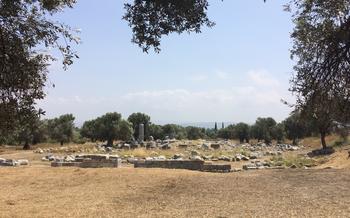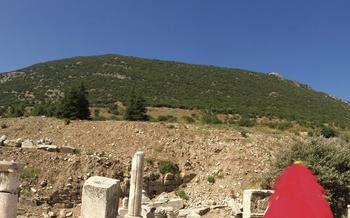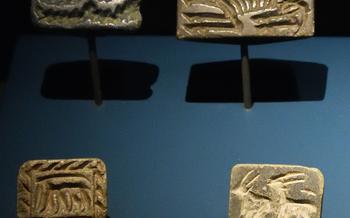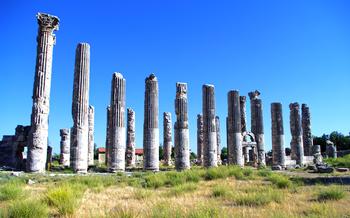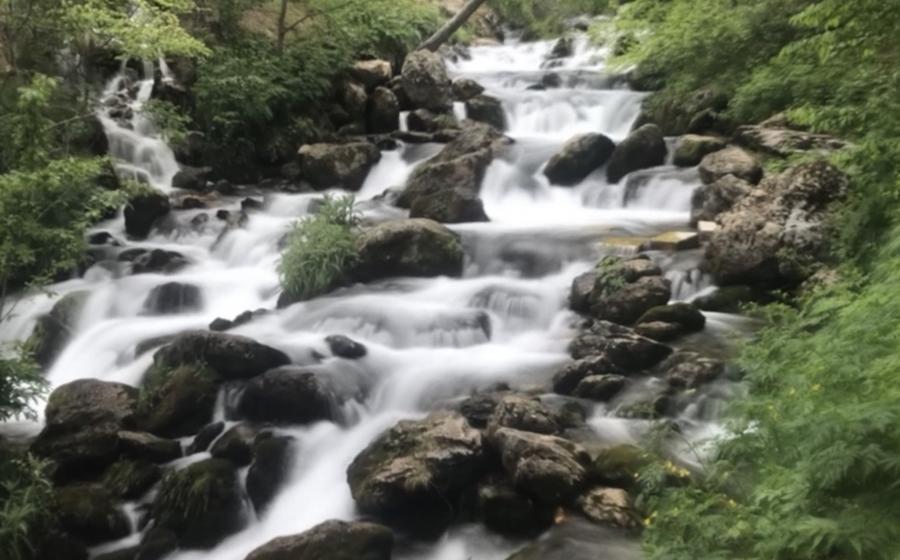
Aizonai Antique City
- Aizonai Antique City: A Hidden Gem in Isparta
- Unveiling the History of Aizonai
- Exploring the Ruins of Aizonai
- Highlights of Aizonai's Theater
- Marveling at the Agora of Aizonai
- Discovering Aizonai's Temples
- Wandering through the Streets of Aizonai
- Uncovering the Necropolis of Aizonai
- Aizonai's Water Systems and Engineering Marvels
- Exploring the Surroundings of Aizonai
- Natural Attractions
- Historical Sites
- Transportation Options
- Planning Your Visit to Aizonai
- Tips for Photography Enthusiasts: Capturing the Essence of Aizonai
- Local Cuisine and Dining Options
- Accommodation Options near Aizonai
- Insider Tip: Uncrowded Exploration
Aizonai Antique City: A Hidden Gem in Isparta
Nestled in the heart of Turkey's Isparta province, Aizonai Antique City stands as a testament to the region's rich cultural heritage. Founded in the 3rd century BC, this ancient city flourished as a significant center of trade and culture throughout the Hellenistic, Roman, and Byzantine eras. What sets Aizonai apart from other ancient sites is its remarkably preserved state, offering visitors a glimpse into the grandeur and sophistication of a bygone era.
Despite its historical significance, Aizonai remains relatively unknown to many travelers, making it a hidden gem waiting to be discovered. Whether you're a history buff, an architecture enthusiast, or simply seeking a serene escape, this ancient city promises an immersive and captivating experience. As you wander through the ruins, let your imagination transport you back in time, when Aizonai was a vibrant metropolis teeming with life and activity.
Planning a visit to Aizonai is a breeze. The site is easily accessible by car or public transportation, and admission fees are minimal. Guided tours are available for those who wish to delve deeper into the city's history and significance. So, if you find yourself in Isparta, be sure to add Aizonai to your itinerary for an unforgettable journey into the past.
Unveiling the History of Aizonai
The history of Aizonai, like a tapestry woven with threads of time, unfolds through various eras, each leaving its unique imprint on the city's identity. Founded in the 3rd century BC by colonists from Sparta, Aizonai flourished as a significant city in the region, reaching its zenith during the Roman period.
During the Roman era, Aizonai became a prominent center of trade and culture, enjoying the patronage of influential figures such as Emperor Hadrian. The city's strategic location along trade routes facilitated its economic prosperity, attracting merchants and artisans from across the region.
Aizonai's rich history is further illuminated by archaeological discoveries that have brought to light fascinating insights into the city's past. Excavations have unearthed well-preserved ruins, revealing intricate mosaics, inscriptions, and artifacts that provide valuable clues about the daily lives, religious practices, and cultural traditions of the ancient Aizonians.
Among the notable historical figures associated with Aizonai is the Roman orator and philosopher Cicero, who visited the city in 51 BC during his travels in the region. His writings and observations offer a glimpse into the city's vibrant atmosphere and its significance as a cultural hub.
The gradual decline of the Roman Empire marked the beginning of a new chapter in Aizonai's history. The city faced challenges and invasions, eventually leading to its abandonment and eventual rediscovery in the 19th century. Today, Aizonai stands as a testament to the enduring legacy of ancient civilizations, inviting visitors to explore its ruins and uncover the secrets of its storied past.
Exploring the Ruins of Aizonai
A stroll through the ruins of Aizonai is a journey through time, revealing the intricate layout and impressive landmarks of this ancient city. The city's theater, with its well-preserved stage and seating rows, stands as a testament to the city's cultural significance. The agora, once a bustling marketplace and civic center, is adorned with shops, stoas, and other structures that hint at the vibrant commercial and social activities that took place here. Temples dedicated to various deities, such as Zeus and Artemis, showcase intricate architectural features and decorative elements, providing a glimpse into the religious beliefs and practices of the Aizonians.
While some parts of the city have been restored, others remain in their original state, offering a glimpse into the ongoing work of archaeologists and the mysteries that Aizonai still holds. The city's streets, lined with well-preserved houses and shops, offer a palpable sense of the daily life and activities that once filled this ancient metropolis.
Highlights of Aizonai's Theater
The theater of Aizonai is one of the most impressive and well-preserved structures within the ancient city. Constructed in the 2nd century AD, this magnificent theater boasts a remarkable blend of architectural styles, showcasing both Hellenistic and Roman influences. With a seating capacity of approximately 2,000 spectators, it is evident that the theater played a crucial role in the cultural and entertainment life of ancient Aizonai.
The theater's architectural features are a testament to the skill and precision of its builders. The stage building, adorned with intricate carvings and sculptures, serves as a backdrop to the orchestra, where performances took place. The seating area, divided into several tiers, rises steeply from the orchestra, ensuring excellent sightlines for all spectators. The theater's acoustics are equally impressive, allowing the voices of performers to carry throughout the auditorium without the need for amplification.
In ancient times, the theater of Aizonai hosted a variety of performances, including theatrical plays, musical concerts, and gladiator fights. It was a place where the community gathered to celebrate festivals, honor their gods, and witness spectacles that showcased the talents of artists and athletes. Today, the theater stands as a silent witness to the vibrant cultural heritage of this ancient city, inviting visitors to step back in time and imagine the sights and sounds that once filled this magnificent space.
Marveling at the Agora of Aizonai
The agora, the heart of every ancient city, was a bustling marketplace and civic center where people gathered to conduct business, socialize, and participate in political and cultural activities. Aizonai's agora is a particularly well-preserved example of this vital urban space.
The agora, a large open square, is surrounded by stoas, or covered walkways, which provided shade and protection from the elements. Shops and stalls lined the stoas, selling a variety of goods, from pottery and textiles to food and spices. The agora was also home to important public buildings, such as the bouleuterion (council house) and the prytaneion (government building).
The bouleuterion, a rectangular building with a raised platform and seating for the city council, was where important decisions were made regarding the governance of Aizonai. The prytaneion, a more elaborate building with a central hearth, was the seat of the city's government and the place where official guests were entertained.
The agora was a vibrant and lively place, where the sounds of haggling merchants, political debates, and cultural performances filled the air. It was a place where people from all walks of life came together to conduct business, share ideas, and celebrate their shared identity as citizens of Aizonai.
Discovering Aizonai's Temples
Aizonai was a deeply religious city, and its temples were central to the lives of its inhabitants. The city boasted several temples dedicated to various deities, each with its unique architectural features and religious significance.
One of the most prominent temples in Aizonai was the Temple of Zeus, the king of the gods. This grand temple was adorned with intricate carvings and sculptures depicting Zeus and his divine entourage. The Temple of Artemis, the goddess of hunting and nature, was another significant religious structure in the city. Its elegant columns and graceful lines reflected the goddess's association with beauty and wilderness.
Other notable temples in Aizonai included the Temple of Apollo, the god of music and healing, and the Temple of Athena, the goddess of wisdom and war. Each temple served as a place of worship, ritual offerings, and religious ceremonies for the city's inhabitants.
Exploring the temples of Aizonai is a journey through the religious beliefs and practices of the ancient Pisidians. Visitors can admire the architectural finesse, marvel at the intricate details, and imagine the sacred rituals that once took place within these hallowed walls.
Wandering through the Streets of Aizonai
The well-preserved streets of Aizonai offer a glimpse into the daily lives of its ancient inhabitants. These cobbled pathways once bustled with activity, connecting various parts of the city and serving as centers of commerce and social interaction.
As you stroll along the streets, admire the architectural features of the houses and shops that line them. Many of these structures feature intricate stonework, decorative lintels, and well-preserved facades. Notice the small niches and alcoves in some of the walls, which may have been used to display religious objects or decorative items.
The streets of Aizonai provide tangible evidence of the city's urban planning and organization. The layout is regular and orderly, with streets intersecting at right angles. This grid-like pattern facilitated efficient movement and access to various parts of the city.
As you explore the streets, pay attention to the small details that reveal traces of daily life in ancient Aizonai. Look for worn-down steps, which hint at the countless footsteps that have traversed these paths over the centuries. Imagine the sounds and smells that once filled the air—the chatter of merchants, the laughter of children playing, and the aroma of fresh bread baking in nearby ovens.
Wandering through the streets of Aizonai is a journey through time, allowing you to connect with the past and envision the vibrant community that once thrived within these ancient walls.
Uncovering the Necropolis of Aizonai
To the west of Aizonai lies its ancient cemetery, known as the necropolis. This vast area holds the final resting places of Aizonai's citizens from various periods of its existence. The necropolis provides valuable insights into the burial customs and beliefs of the ancient inhabitants.
Among the different types of tombs found in the necropolis are rock-cut tombs, chamber tombs, and sarcophagi. Rock-cut tombs are carved directly into the rocky hillside and often feature multiple chambers and niches for burials. Chamber tombs are constructed using stone blocks and have a distinct entrance leading to an interior burial chamber. Sarcophagi, elaborately carved stone coffins, are another common sight in the necropolis.
Notable tombs include the "Tomb of the Lion," which features a majestic lion sculpture at its entrance, and the "Tomb of the Priest," which contains inscriptions providing insights into the life and religious practices of an ancient priest. Funerary inscriptions found on tombstones and stelae offer glimpses into the names, family lineages, and occupations of the deceased.
Exploring the necropolis is a poignant experience that connects visitors with the lives and deaths of Aizonai's past residents. It highlights the importance placed on honoring the dead and provides a glimpse into the funerary traditions of this ancient city.
Aizonai's Water Systems and Engineering Marvels
In ancient Aizonai, water management was a crucial aspect of daily life and urban planning. The city's inhabitants demonstrated remarkable engineering skills by developing sophisticated water systems that ensured a reliable and abundant water supply.
One of the most impressive feats of Aizonai's water management system was the construction of aqueducts. These massive structures, often built with stone or brick, transported water from distant sources, such as springs or rivers, into the city. The aqueducts were carefully engineered to maintain a gentle gradient, allowing water to flow smoothly and consistently.
Within the city, a network of underground channels and pipes distributed water to various fountains, baths, and residential areas. Cisterns, large underground reservoirs, were also constructed to store excess water for use during dry periods or in case of emergencies. The cisterns were often strategically placed throughout the city to ensure that water was easily accessible to all residents.
The engineering techniques employed in Aizonai's water systems showcased the city's advanced knowledge of hydraulics and water conservation. The careful management of water resources not only sustained the population's daily needs but also contributed to the city's overall health and sanitation.
Exploring the Surroundings of Aizonai
Surrounding the ancient city of Aizonai lies a tapestry of natural wonders and historical treasures waiting to be discovered. Immerse yourself in the picturesque landscapes, where verdant valleys meet rugged mountains, and uncover hidden gems that tell the tales of civilizations past.
Natural Attractions
Just a short distance from Aizonai, you'll find the breathtaking Eğirdir Lake, a sparkling expanse of turquoise waters surrounded by lush forests and charming villages. Indulge in swimming, boating, and fishing amidst the tranquil beauty of this natural wonder.
Historical Sites
Delve deeper into the region's rich history by visiting the nearby village of Eğirdir, where you can explore the Eğirdir Castle, a magnificent fortress that once served as a strategic stronghold. The village itself is a treasure trove of Ottoman-era architecture, with traditional houses and narrow cobblestone streets that transport you back in time.
Transportation Options
Getting around the area is a breeze, with various transportation options available. Rent a car for the freedom to explore at your own pace, or hop on a local bus or taxi to easily reach your desired destinations.
Whether you seek adventure in the great outdoors or a journey through the annals of history, the surroundings of Aizonai offer an abundance of experiences to enrich your visit to this ancient city.
Planning Your Visit to Aizonai
To make the most of your visit to Aizonai, careful planning is essential. The ideal time to visit is during the shoulder seasons (spring or autumn) when the weather is pleasant and the crowds are smaller. For a more immersive experience, consider joining a guided tour led by knowledgeable experts who can provide insights into the city's history and significance. Entrance fees are typically affordable, and discounts are often available for students, seniors, and groups.
Once inside the ancient city, you'll find basic amenities such as restrooms and drinking water fountains. While exploring the ruins, remember to wear comfortable shoes and bring along a hat, sunscreen, and plenty of water, especially during the summer months. For a more comprehensive understanding of Aizonai's history and culture, consider purchasing a guidebook or hiring a local guide who can share their expertise and bring the site to life.
Tips for Photography Enthusiasts: Capturing the Essence of Aizonai
The ancient city of Aizonai offers a treasure trove of photographic opportunities for enthusiasts of all skill levels. Here are some tips to help you capture the essence of this remarkable site:
-
Golden Hours: Arrive at Aizonai early in the morning or late in the afternoon to take advantage of the warm, golden light that casts a magical glow on the ruins. These hours are ideal for capturing dramatic shots with rich colors and textures.
-
Experiment with Angles: Don't be afraid to experiment with different angles and perspectives to create unique and visually appealing shots. Climb to higher vantage points, such as the theater's seating area, for panoramic views of the site.
-
Focus on Details: While wide-angle shots can be impressive, don't forget to zoom in on the intricate details that make Aizonai special. Capture the weathered carvings on the temple walls, the worn steps of the theater, or the delicate patterns on the mosaic floors.
-
Mind the Lighting: Pay attention to the direction and intensity of the light to avoid harsh shadows or overexposed areas. Use a polarizing filter to reduce glare and enhance the colors of the ruins.
-
Photography Permits: Photography is generally allowed at Aizonai, but it's a good idea to check with the local authorities or guides regarding any specific regulations or permits required.
-
Camera Settings: For optimal results, use a wide-angle lens to capture the vastness of the site and a telephoto lens for close-up shots. A tripod can help stabilize your camera for sharp and steady images.
Local Cuisine and Dining Options
Savory Delights and Culinary Adventures in Isparta
Isparta's culinary scene is a harmonious blend of traditional Anatolian flavors and modern culinary influences. While exploring the ancient city of Aizonai, take a break to indulge in the region's delectable offerings.
For a taste of authentic Isparta cuisine, try the mouthwatering keşkek, a hearty stew made with lamb, wheat, and chickpeas. Savor the succulent Isparta güveci, a clay pot dish featuring tender lamb or chicken cooked with vegetables and topped with a flaky pastry crust.
Don't miss the Isparta gülü, a fragrant rose petal jam that adds a touch of sweetness to your culinary journey. Pair it with a cup of Turkish coffee for a delightful afternoon treat.
For a quick bite, sample the Isparta pidesi, a traditional Turkish flatbread topped with various savory fillings. Vegetarians will delight in the gözleme, a thin flatbread stuffed with cheese, spinach, or potatoes.
When in Isparta, be sure to visit the local bazaar, where you can find an array of fresh produce, spices, and traditional sweets. Engage with the friendly vendors and let them guide you towards the most authentic culinary treasures.
For a memorable dining experience, head to one of the charming restaurants nestled near the ancient city. Enjoy panoramic views of the ruins while savoring the flavors of Isparta's culinary heritage.
Whether you prefer a casual café or a fine-dining establishment, Isparta offers a diverse range of options to suit every taste and budget. Embrace the opportunity to tantalize your taste buds and create lasting memories with every bite.
Accommodation Options near Aizonai
When planning your trip to Aizonai, a variety of accommodation options await you in the nearby city of Isparta. From budget-friendly guesthouses to comfortable hotels and charming homestays, there's something to suit every traveler's preference and budget.
For those seeking convenience and proximity to the ancient city, numerous hotels and guesthouses are located within walking distance or a short drive from Aizonai. These accommodations offer easy access to the ruins and other attractions in the area, allowing you to maximize your time exploring the site.
Budget-conscious travelers will find a range of affordable options, including hostels and guesthouses, that provide basic yet comfortable accommodation. These establishments often offer shared rooms and facilities, making them an ideal choice for solo travelers or groups of friends.
For a more personalized and immersive experience, consider staying in a traditional Turkish homestay. These homestays offer a unique opportunity to connect with local families and gain insights into Turkish culture and hospitality. Enjoy home-cooked meals, cozy accommodations, and the chance to interact with your hosts, who can provide valuable tips and recommendations for exploring the region.
When booking your accommodation, it's advisable to reserve in advance, especially during peak tourist season, to secure your preferred choice and avoid disappointment. Online booking platforms and local travel agencies can assist you in finding the best deals and availability.
Insider Tip: Uncrowded Exploration
To truly immerse yourself in the magic of Aizonai without the distractions of large crowds, consider visiting early in the morning or late in the afternoon. These times offer a serene atmosphere and ample opportunities to capture stunning photographs without hordes of tourists in the background.
Venture beyond the main tourist areas and explore the lesser-known corners of the site. Discover hidden gems like the smaller temples, residential neighborhoods, and secluded streets that offer a glimpse into the daily lives of Aizonai's ancient inhabitants.
For an even more enriching experience, engage with local guides or historians who can provide fascinating insights into the city's history and culture. They can point out hidden details, share captivating stories, and bring the ruins to life before your eyes.
